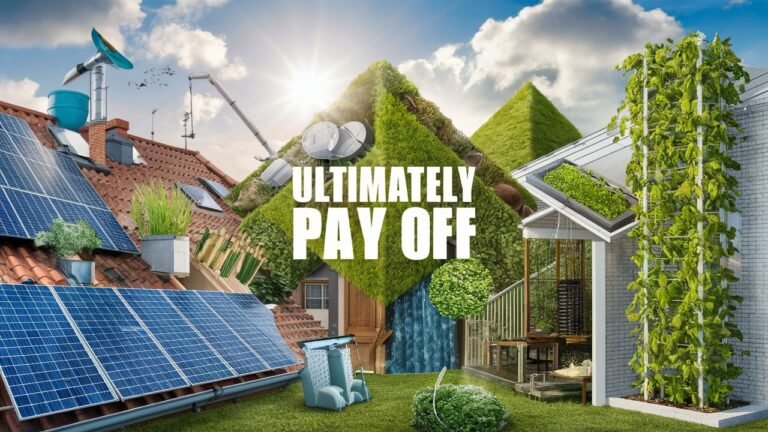Making your home more sustainable doesn’t just benefit the planet—it can significantly boost your bank account too. Smart homeowners are discovering that eco-friendly upgrades often deliver impressive returns through reduced utility bills, increased property values, and long-term savings that compound over years.
The best sustainable home improvements combine environmental responsibility with financial wisdom. Rather than viewing green upgrades as expensive luxuries, savvy homeowners recognize them as strategic investments that pay dividends for decades. From energy-efficient appliances to smart home technology, these solutions create a win-win scenario where you save money while reducing your environmental footprint.
Understanding which sustainable upgrades offer the best return on investment helps you prioritize improvements that align with both your budget and environmental goals. Let’s explore the most effective sustainable home solutions that deliver measurable financial benefits.
Energy-Efficient Windows and Doors
Upgrading to energy-efficient windows represents one of the most impactful sustainable investments you can make. High-quality replacement windows significantly reduce heating and cooling costs while improving indoor comfort year-round. Whether you’re considering windows in Logan UT or anywhere else, modern energy-efficient models feature advanced technologies like low-E coatings, argon gas fills, and multi-pane construction that dramatically improve insulation.
Energy-efficient doors work alongside windows to create a comprehensive thermal barrier. These upgrades typically reduce energy bills by 10-25% annually, with payback periods ranging from 7-15 years depending on your local climate and energy costs. Beyond immediate savings, these improvements increase property values and appeal to environmentally conscious buyers.
Smart Home Technology Integration
Smart thermostats lead the charge in home automation solutions that pay for themselves quickly. These devices learn your schedule and preferences, automatically adjusting temperatures to minimize energy waste without sacrificing comfort. Most homeowners see 10-15% reductions in heating and cooling costs, with simple payback periods of 2-3 years.
Smart lighting systems extend these savings throughout your home. LED bulbs combined with motion sensors and programmable controls eliminate energy waste from lights left on unnecessarily. Smart power strips prevent phantom energy drain from electronics in standby mode, addressing a hidden source of electrical consumption that can account for 5-10% of household energy use.
Solar Energy Systems
Solar panel installations have become increasingly affordable while delivering substantial long-term returns. Federal tax credits, state incentives, and net metering programs significantly reduce upfront costs while creating ongoing savings. Most residential solar systems pay for themselves within 6-10 years, then continue generating free electricity for 20+ additional years.
Battery storage systems enhance solar investments by storing excess energy for use during peak rate periods or power outages. While adding to initial costs, batteries maximize solar system value and provide energy security that’s increasingly valuable as grid reliability faces challenges from extreme weather events.
Water Conservation Systems
Low-flow fixtures throughout your home reduce water usage without compromising performance. Modern low-flow showerheads, toilets, and faucets can cut water consumption by 20-40% compared to older models. These relatively inexpensive upgrades typically pay for themselves within 2-4 years through reduced water bills.
Rainwater harvesting systems capture and store precipitation for landscape irrigation, reducing municipal water costs while supporting drought-resistant gardening practices. Simple rain barrels offer affordable entry points, while comprehensive cistern systems provide larger-scale water independence for properties with significant outdoor water needs.
High-Performance Insulation
Upgrading insulation in attics, walls, and basements creates immediate comfort improvements while reducing energy consumption year-round. Modern insulation materials like spray foam and advanced fiberglass products offer superior performance compared to older insulation that may have settled or degraded over time.
Air sealing complements insulation upgrades by eliminating drafts and thermal bridges that compromise energy efficiency. Professional energy audits identify problem areas where conditioned air escapes, allowing targeted improvements that maximize return on investment. These combined upgrades often reduce heating and cooling costs by 15-30%.
Energy-Efficient Appliances
ENERGY STAR certified appliances consume significantly less electricity and water than standard models while delivering equivalent or superior performance. Refrigerators, washing machines, dishwashers, and water heaters offer the greatest savings potential due to their constant operation and high energy consumption.
Heat pump technology represents a particularly valuable appliance upgrade, providing both heating and cooling with exceptional efficiency. Modern heat pumps work effectively even in cold climates, offering 2-3 times the efficiency of traditional heating systems while reducing carbon emissions.
Sustainable Landscaping Solutions
Drought-resistant landscaping reduces outdoor water consumption while creating beautiful, low-maintenance yards. Native plants naturally thrive in local conditions without extensive irrigation, fertilization, or pest control treatments. These landscapes support local ecosystems while dramatically reducing ongoing maintenance costs.
Permeable paving materials for driveways and walkways manage stormwater runoff while reducing heat island effects around your home. These surfaces allow rainwater to infiltrate naturally, reducing strain on municipal drainage systems while creating cooler outdoor environments during hot weather.
Your Path to Sustainable Savings
Sustainable home improvements offer compelling financial returns alongside environmental benefits. Start with energy audits to identify your home’s biggest opportunities, then prioritize upgrades based on payback periods and available incentives. Many utility companies offer rebates and financing programs that improve project economics while supporting your sustainability goals.
Remember that sustainable improvements often work synergistically—combining multiple upgrades amplifies both environmental impact and financial returns. Focus on creating comprehensive solutions rather than isolated improvements to maximize your investment’s long-term value.
